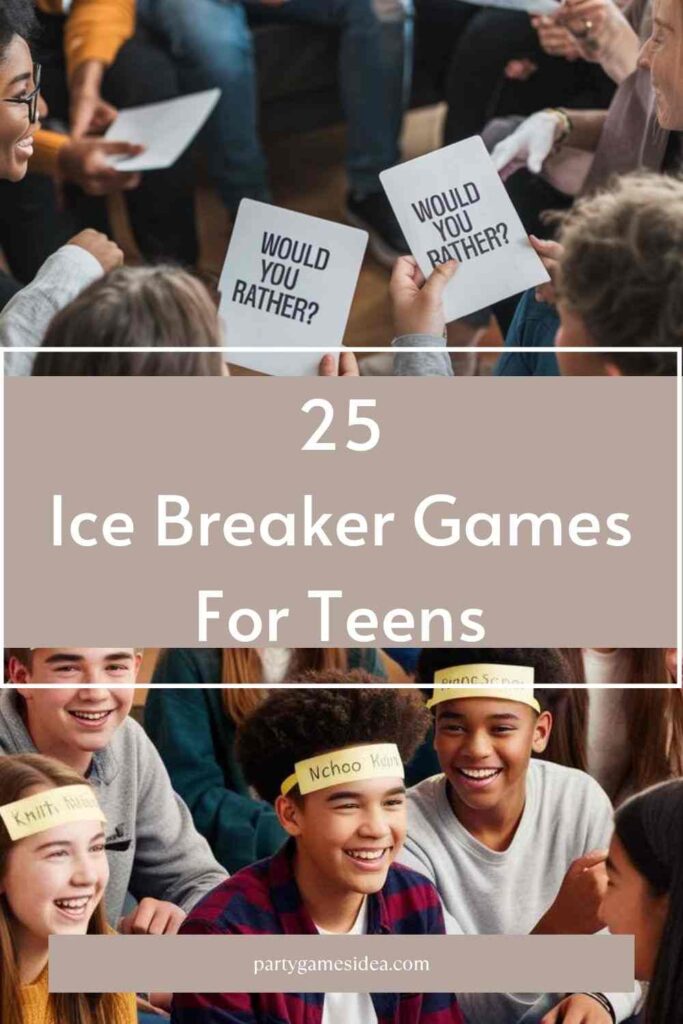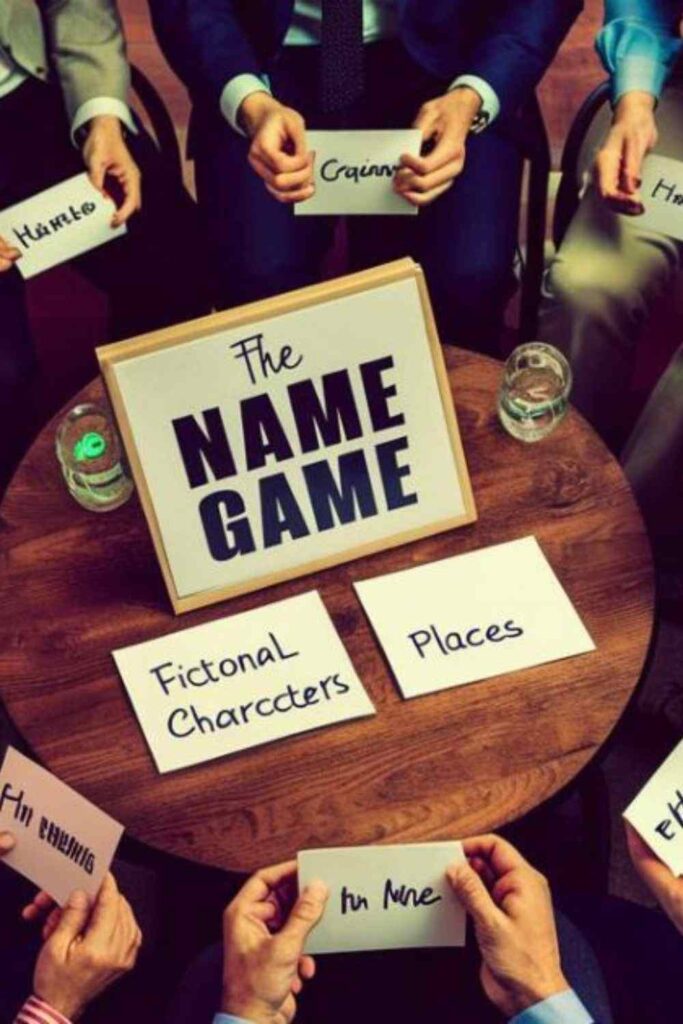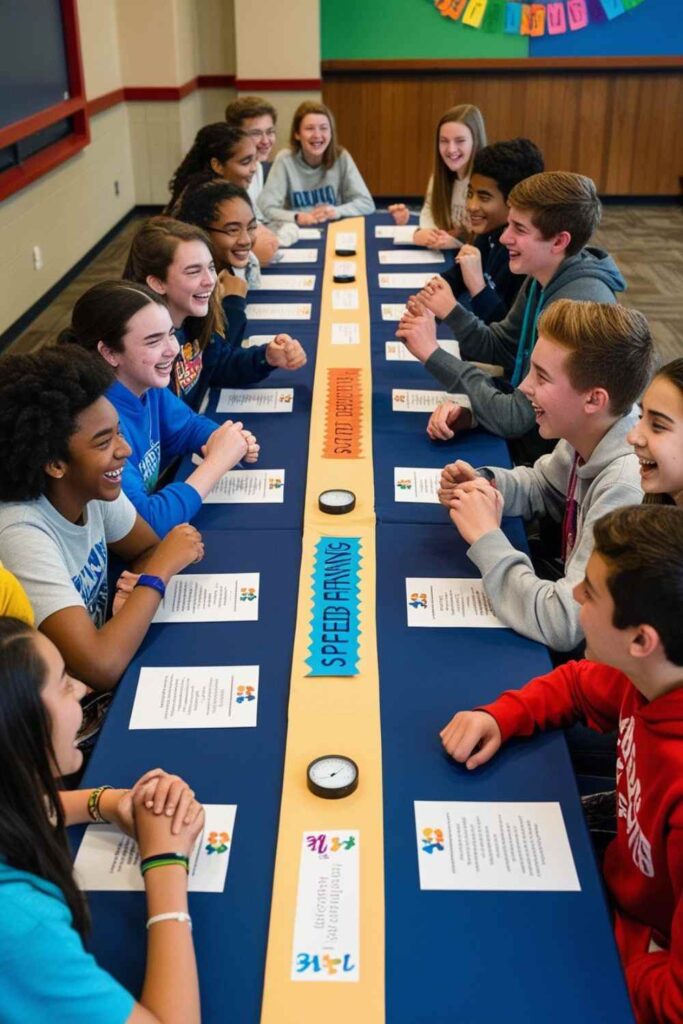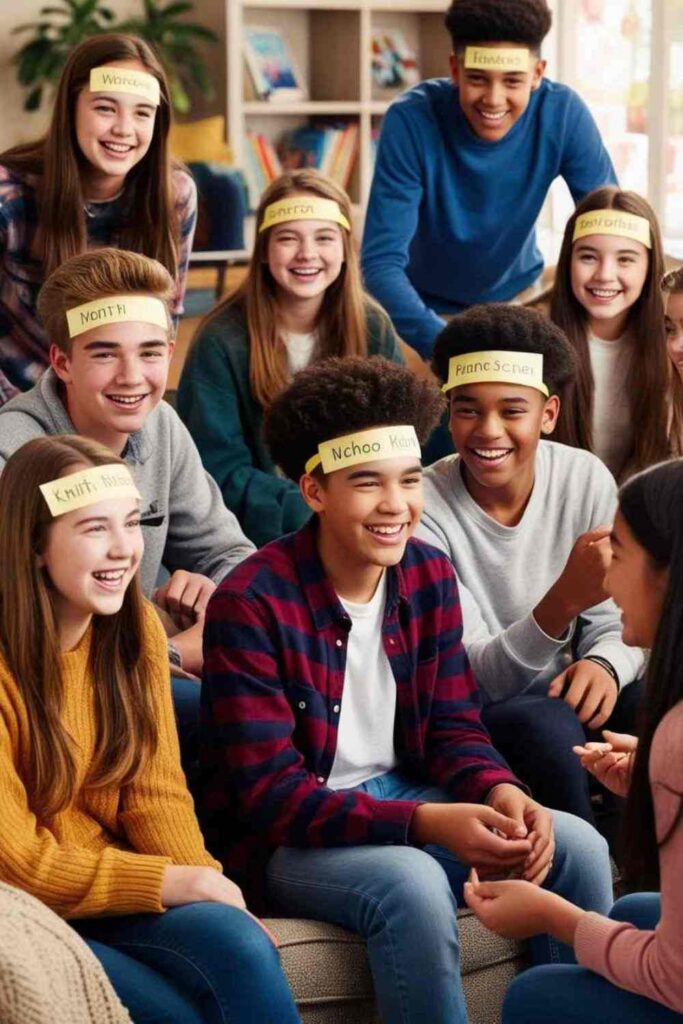Ice Breaker Games For Teens play a crucial role in creating a welcoming and comfortable atmosphere in social settings. Whether it’s the first day of school, a youth group gathering, or a new club meeting, teens often face the challenge of interacting with unfamiliar peers. Ice breaker games are designed to ease this initial tension, helping teens feel more at ease and open to engaging with others. By participating in these activities, teens can break down social barriers, making it easier to connect and form new friendships.
The beauty of ice breaker games for teens lies in their versatility. These games are not one-size-fits-all; they can be adapted to suit different group sizes, environments, and even the specific interests of the teens involved. From small, intimate settings to large group events, there are ice breaker games that fit every occasion. Whether indoors or outdoors, in a classroom or a park, these games can be tailored to create an environment where teens feel comfortable and ready to participate.
In essence, ice breaker games for teens are more than just fun activities—they are essential tools for fostering a sense of belonging and connection. By carefully selecting and adapting these games to the needs of the group, facilitators can ensure that every teen has the opportunity to feel included and engaged.
Ice Breaker Games For Teens
Icebreaker games for teens are fun and engaging activities designed to help young people get to know each other, build connections, and break down social barriers in a relaxed and playful environment. These games are perfect for group settings like school events, camps, youth groups, or any gathering where teens may be meeting for the first time or need a little boost to start interacting. From quick and simple games to more involved challenges, icebreakers encourage participation, spark conversation, and set the tone for a fun and friendly atmosphere.
Teens Two Truths and a Lie
A classic ice breaker game that encourages teens to share interesting facts about themselves while keeping everyone guessing.
Rules:
- Each participant takes turns stating three facts about themselves: two true and one false.
- The rest of the group tries to guess which statement is the lie.
Tips:
- Encourage creativity in the statements to make the game more engaging.
- Remind participants to choose statements that are not too obvious.
Human Knot
A physical activity that promotes teamwork and problem-solving as teens work together to untangle themselves from a “knot.”
Rules:
- Participants stand in a circle and hold hands with two different people across from them.
- Without letting go, they must work together to untangle themselves into a circle.
Tips:
- Ensure the group has enough space to move around.
- Encourage communication and patience.
Teens Would You Rather?
A fun game that sparks conversation and debates by presenting participants with two challenging choices.
Rules:
- Pose a series of “Would you rather” questions to the group.
- Participants must choose one option and explain their choice if desired.
Tips:
- Choose questions that are age-appropriate and relevant to the group’s interests.
- Allow time for discussion to deepen the engagement.
The Name Game for Teens
A simple yet effective game for remembering names and breaking the ice, especially useful in new or large groups.
Rules:
- Each participant says their name and adds an adjective that describes them and starts with the same letter as their name (e.g., “Jovial Jake”).
- The next person repeats the previous names and adjectives before adding their own.
Tips:
- Encourage creativity in the adjectives to make the game more memorable.
- Use a small reward for the person who remembers the most names.
Teens Charades
A classic game that combines creativity and non-verbal communication as participants act out prompts for others to guess.
Rules:
- Write down different prompts or categories on slips of paper.
- Participants take turns drawing a slip and acting out the prompt without speaking.
Tips:
- Use categories that are familiar to the group to make guessing easier.
- Encourage exaggerated actions and facial expressions.
Speed Friending
A game similar to speed dating, but focused on making new friends and finding common interests quickly.
Rules:
- Participants rotate and have a set amount of time (e.g., 2 minutes) to chat with each person.
- Provide a few conversation starter questions if needed.
Tips:
- Create a welcoming atmosphere with comfortable seating.
- Encourage participants to share interesting facts or hobbies.
Mingle Mingle
A dynamic game that gets everyone moving and interacting by following specific prompts or instructions.
Rules:
- The leader calls out various instructions (e.g., “Mingle with someone who has the same favorite color”).
- Participants must find and interact with others based on the instructions.
Tips:
- Keep the prompts varied and inclusive to ensure everyone gets a chance to participate.
- Monitor the group to ensure everyone is engaged.
Teens Who Am I?
A guessing game where participants figure out the identity of a famous person or character based on clues provided by others.
Rules:
- Each participant has a name tag with the name of a famous person or character placed on their forehead without seeing it.
- Participants ask yes-or-no questions to figure out their identity.
Tips:
- Choose well-known names that are likely familiar to the group.
- Encourage participants to think creatively with their questions.
Four Corners
An energetic game that involves physical movement and decision-making as participants choose a “corner” based on various prompts.
Rules:
- Assign a different option to each corner of the room (e.g., favorite activities).
- The leader announces a prompt, and participants move to the corner that represents their choice.
Tips:
- Ensure the game area is safe for movement.
- Use prompts that are engaging and relevant to the group’s interests.
Pictionary
A drawing and guessing game where participants illustrate prompts for their team to guess within a time limit.
Rules:
- Write down prompts on slips of paper and place them in a bowl.
- One person draws a prompt while their team guesses within a time limit.
Tips:
- Provide a timer to keep the game moving.
- Choose prompts that are familiar and fun for the group.
Icebreaker Bingo
A variation of bingo where participants find people who match certain characteristics on their bingo card.
Rules:
- Create bingo cards with various traits or experiences (e.g., “Has traveled to another country”).
- Participants mingle and find others who match the traits to mark off their cards.
Tips:
- Customize the traits to fit the group’s interests and experiences.
- Offer small prizes for completed bingo cards to encourage participation.
Telephone
A game that tests the accuracy of communication as a message is whispered through a line of participants.
Rules:
- One person thinks of a message and whispers it to the next person in line.
- Each person whispers the message to the next until it reaches the last person, who says it out loud.
Tips:
- Choose a simple and clear message to avoid confusion.
- Emphasize that the fun is in the distortion of the message.
The Alphabet Game
A word game where participants come up with words related to a specific category, starting with each letter of the alphabet.
Rules:
- Choose a category (e.g., animals).
- Participants take turns naming an item that fits the category and starts with each letter of the alphabet.
Tips:
- Select categories that are familiar and interesting to the group.
- Encourage creativity and quick thinking.
What’s in the Bag?
A tactile game where participants guess the contents of a bag without looking, promoting curiosity and interaction.
Rules:
- Place various small items in a bag.
- Participants reach into the bag without looking and try to guess the items based on touch.
Tips:
- Choose items with distinct textures to make guessing easier.
- Ensure the bag is opaque to prevent peeking.
Desert Island
A thought-provoking game where participants choose items they would bring if stranded on a desert island, fostering conversation and debate.
Rules:
- Each participant lists three items they would bring to a desert island and explains why.
- Discuss the choices as a group to understand different perspectives.
Tips:
- Encourage creative and practical thinking.
- Use the game to spark conversations about survival and preferences.
Personality Quiz
A game that involves taking a fun personality quiz and sharing the results, which can reveal common interests and traits.
Rules:
- Provide a short, engaging personality quiz (e.g., “Which superhero are you?”).
- Participants take the quiz and share their results with the group.
Tips:
- Use quizzes that are light-hearted and enjoyable.
- Discuss the results to find commonalities and differences.
Story Cubes
A creative game where participants roll dice with pictures and use the images to create and share a story.
Rules:
- Roll dice with different images on each face.
- Use the images that come up to create a short story on the spot.
Tips:
- Encourage imagination and creativity.
- Allow participants to build on each other’s stories for added fun.
Guess the Sound
An auditory game where participants listen to various sounds and try to identify them, promoting active listening and engagement.
Rules:
- Play a series of recorded sounds or use household items to make sounds.
- Participants guess the source of each sound.
Tips:
- Choose sounds that are distinct and recognizable.
- Offer hints if participants are struggling to guess.
Paper Airplane Contest
A competitive and fun game where participants design and fly paper airplanes, encouraging creativity and friendly competition.
Rules:
- Provide materials for making paper airplanes.
- Participants design and fly their planes, with awards for distance, accuracy, or creativity.
Tips:
- Offer instructions for making different types of planes for variety.
- Set up a designated flying area to ensure safety.
Scavenger Hunt
A dynamic game that involves finding and collecting specific items or completing tasks, promoting teamwork and problem-solving.
Rules:
- Create a list of items or tasks for participants to find or complete.
- Divide into teams and set a time limit for finding the items or completing tasks.
Tips:
- Tailor the list to the location and group’s interests.
- Use clues and riddles to make the hunt more engaging.
Musical Chairs
A classic game that combines music and movement with a fun elimination twist, ideal for energetic groups.
Rules:
- Arrange chairs in a circle, one fewer than the number of participants.
- Play music as participants walk around the chairs, and when the music stops, they must find a seat.
Tips:
- Use lively music to keep the game exciting.
- Ensure that the game area is free of obstacles.
Flashlight Tag
A nighttime game that combines tag with the challenge of using a flashlight, adding an element of excitement and strategy.
Rules:
- One person is “it” and has a flashlight.
- The “it” person tries to tag others by shining the flashlight on them.
Tips:
- Play in a safe, enclosed area to prevent accidents.
- Ensure everyone understands the rules before starting.
Truth or Dare
A classic game where participants choose between answering a question truthfully or performing a dare, fostering fun and spontaneity.
Rules:
- Participants take turns choosing “truth” or “dare.”
- The group provides a question or dare, which must be answered or performed.
Tips:
- Keep dares and questions appropriate for the group.
- Ensure everyone feels comfortable with the game’s content.
Name That Tune
A musical game where participants guess the title or artist of a song based on short audio clips, perfect for music enthusiasts.
Rules:
- Play short clips from various songs.
- Participants guess the song title or artist.
Tips:
- Choose a mix of popular and recognizable songs.
- Use a buzzer or raise hands to keep the game organized.
These ice breaker games for teens can help create a lively and interactive atmosphere, making it easier for everyone to connect and have fun.
Benefits of Ice Breaker Games for Teens
Ice breaker games offer a range of benefits for teens, helping them navigate social situations with ease and confidence. These activities are more than just fun; they play a crucial role in fostering a positive social environment. Here’s how ice breaker games can positively impact teens:
Encourages Social Interaction and Teamwork
- Facilitates Engagement: Ice breaker games encourage teens to interact with each other, promoting active engagement and participation.
- Builds Teamwork Skills: These games often require collaborative effort, teaching teens to work together, share ideas, and achieve common goals.
- Enhances Communication: Through structured activities, teens practice effective communication, learning how to articulate their thoughts and listen to others.
Helps Shy or Introverted Teens Feel More Included
- Reduces Social Anxiety: Ice breaker games create a supportive environment where shy or introverted teens can gradually feel more comfortable participating.
- Encourages Participation: The low-pressure nature of these games helps quieter teens feel welcomed and valued, making it easier for them to join in.
- Builds Confidence: By providing opportunities to interact in a relaxed setting, ice breaker games help boost the confidence of shy teens, making social situations less intimidating.
Breaks Down Social Barriers and Builds Connections
- Promotes Inclusivity: Ice breaker games help dismantle social barriers by creating shared experiences, which fosters a sense of inclusivity among participants.
- Encourages Friendships: As teens work together and engage in activities, they are more likely to form new friendships and strengthen existing connections.
- Reduces Cliques: These games help diminish the divide between different social groups by encouraging everyone to interact and collaborate.
Boosts Confidence in Speaking and Participating
- Enhances Public Speaking Skills: Participating in ice breaker games allows teens to practice speaking in front of others, building their confidence in public speaking.
- Encourages Active Participation: By involving teens in interactive activities, ice breaker games promote active participation, making teens more comfortable in group settings.
- Fosters Self-Esteem: Successfully engaging in these activities boosts self-esteem, as teens gain confidence in their ability to contribute and express themselves.
Overall, ice breaker games provide numerous benefits for teens by promoting social interaction, inclusivity, and self-confidence. These activities help create a positive environment where teens can build relationships, improve their social skills, and feel more comfortable in group settings.
Factors to Consider When Choosing Ice Breaker Games
Selecting the right ice breaker game for a group involves considering several key factors to ensure the activity is engaging, appropriate, and effective. By taking into account the following elements, you can tailor your ice breaker games to fit the needs and dynamics of your group.
Group Size: Small vs. Large Groups
- Small Groups: For smaller groups, you can opt for more intimate and interactive games that allow everyone to participate actively. These games often involve personal sharing and detailed interactions, which are manageable in a small setting.
- Large Groups: In larger groups, choose games that can accommodate many participants and facilitate broad interaction. Activities that divide the group into smaller teams or use a structured format can help maintain engagement and manage the crowd effectively.
Space Available: Indoor vs. Outdoor
- Indoor: Indoor spaces often require games that are less physically demanding and can be conducted within limited space. Consider games that involve minimal movement and can be played at a table or in a confined area.
- Outdoor: Outdoor settings offer more flexibility and room for physical activities. Games that involve running, movement, or larger setups can be ideal for outdoor environments, taking advantage of the open space.
Time Constraints: Quick Games vs. Longer Activities
- Quick Games: When time is limited, opt for ice breaker games that are easy to explain and can be completed quickly. These games should be straightforward and designed to fit within a short time frame, ensuring that they effectively break the ice without consuming too much time.
- Longer Activities: For more extended periods, you can choose games that involve multiple rounds or deeper interactions. These activities can include more complex challenges or discussions, providing a more thorough opportunity for participants to connect.
Age-Appropriateness and Interests of the Group
- Age-Appropriate Games: Tailor the games to the age group of the participants to ensure they are engaging and suitable. Younger participants might enjoy more active or simple games, while older teens may prefer more strategic or discussion-based activities.
- Interests: Consider the interests and preferences of the group when selecting games. Games that align with the participants’ hobbies or current trends are more likely to capture their attention and enthusiasm.
Comfort Levels: Avoiding Games that Might Embarrass or Alienate Participants
- Sensitive Content: Choose games that avoid potentially embarrassing or uncomfortable topics. Avoid activities that may involve personal or sensitive information that could make participants feel uneasy.
- Inclusivity: Ensure that the games are inclusive and respectful of all participants. Activities should be designed to include everyone, without singling out individuals or creating situations where some might feel left out or uncomfortable.
By carefully considering these factors, you can select ice breaker games that effectively meet the needs of your group, promote positive interaction, and ensure a fun and inclusive experience for everyone involved.
Tips for Facilitating Ice Breaker Games
Facilitating ice breaker games effectively requires a thoughtful approach to ensure that the activity is enjoyable, inclusive, and respectful of everyone’s boundaries. Here are some tips to help you set the right tone, encourage participation, and address any issues that may arise during the game.
How to Set a Positive Tone and Ensure Everyone Feels Included
- Start with Enthusiasm: Begin the game with a positive and enthusiastic attitude. Your energy sets the tone for the activity and can help create a welcoming atmosphere.
- Clearly Explain the Game: Provide clear and concise instructions to ensure everyone understands how to participate. This helps reduce any confusion or anxiety about the game.
- Foster Inclusivity: Make an effort to include everyone by encouraging participation and ensuring that no one feels left out. Use language that is inclusive and supportive to make all participants feel valued.
Encouraging Participation Without Pressure
- Create a Supportive Environment: Encourage participation by creating a safe and supportive environment. Let participants know that their involvement is appreciated, but avoid putting undue pressure on them to join in.
- Offer Alternatives: If a game involves activities that might be uncomfortable for some, offer alternative ways to participate. This allows everyone to engage at their own comfort level.
- Be Flexible: Allow participants to opt out or take a break if needed. Flexibility ensures that everyone can participate in a way that feels right for them.
Balancing Fun with Respect for Personal Boundaries
- Be Mindful of Boundaries: Choose games that respect personal boundaries and avoid sensitive topics. Be aware of any individual concerns or limitations and ensure the activities are comfortable for everyone.
- Monitor Reactions: Pay attention to participants’ reactions during the game. If someone appears uncomfortable or reluctant, address their concerns promptly and adjust the activity if necessary.
- Encourage Respect: Promote a culture of respect by emphasizing that all participants should be considerate of each other’s feelings and boundaries.
How to Deal with Resistance or Disengagement
- Address Concerns Privately: If a participant is resistant or disengaged, approach them privately to understand their concerns. Offer reassurance and discuss ways to make the game more comfortable for them.
- Adjust the Game: If you notice general disengagement, consider modifying the game or switching to a different activity. Sometimes, a change in approach can re-engage the group and rekindle interest.
- Maintain Positivity: Keep a positive attitude and focus on the aspects of the game that are working well. Acknowledge and appreciate the efforts of participants who are engaged, which can help boost overall morale.
By applying these tips, you can facilitate ice breaker games that are enjoyable, inclusive, and respectful, ensuring that all participants feel comfortable and engaged throughout the activity.
FAQ
What are ice breaker games for teens?
Ice breaker games for teens are interactive activities designed to help individuals become more comfortable with each other and foster a sense of camaraderie in group settings. These games are typically used at the beginning of events, gatherings, or social interactions to ease tension and facilitate communication. Here’s a closer look at what ice breaker games for teens entail:
- Purpose: Ice breaker games aim to reduce social anxiety, encourage participation, and create a welcoming environment. They help participants get to know each other in a fun and relaxed way, making it easier to engage in further group activities.
- Types of Games: Ice breaker games can vary widely in format and complexity. They may include simple activities like “Two Truths and a Lie,” where participants share interesting facts about themselves, or more involved games such as team-building challenges that require collaboration.
- Benefits: These games help teens feel more comfortable in social settings, build connections, and develop communication skills. They also provide a platform for everyone to participate and share, promoting inclusivity and mutual understanding.
- Settings: Ice breaker games can be adapted for different environments, whether indoors or outdoors, and for various group sizes. The choice of game often depends on the space available, the time allotted, and the interests of the participants.
Overall, ice breaker games for teens play a crucial role in fostering a positive and engaging atmosphere, making it easier for teens to connect and interact with one another.
Why are ice breaker games important for teens?
Ice breaker games are important for teens because they help ease social interactions and build connections in a comfortable setting. These games reduce anxiety by creating a fun and relaxed environment, making it easier for teens to engage with others. They also promote teamwork and communication skills, which are valuable for personal and social development. Additionally, ice breaker games help teens feel included and valued, which is crucial for fostering a sense of community and belonging.
How do I choose the right ice breaker game for my group?
To choose the right ice breaker game for your group, consider the following factors:
- Group Size: Select games that fit the number of participants. For small groups, choose activities that encourage detailed interactions, while for larger groups, opt for games that can be scaled or divided into teams.
- Available Space: Consider whether the game requires indoor or outdoor space. Choose games that match the physical constraints of your venue, whether it’s a confined room or an open area.
- Time Constraints: Pick games that fit within the available time. For brief sessions, choose quick and easy games, whereas for longer periods, you can opt for more involved activities.
- Age and Interests: Match the game to the age and interests of the participants to ensure it’s engaging and appropriate. Consider their preferences to increase enthusiasm and participation.
- Comfort Levels: Ensure the game respects personal boundaries and is inclusive. Avoid activities that might make participants feel uncomfortable or singled out.
By evaluating these factors, you can select an ice breaker game that enhances interaction, suits the group’s needs, and creates a positive experience for everyone involved.
How can I ensure that all participants feel included during the game?
To ensure that all participants feel included during an ice breaker game, follow these strategies:
- Set a Positive Tone: Begin with enthusiasm and a welcoming attitude. Make it clear that the goal is to have fun and that everyone’s participation is valued.
- Clearly Explain the Rules: Provide simple and clear instructions so everyone understands how to participate. This helps reduce confusion and ensures that everyone knows what to expect.
- Encourage Participation: Invite everyone to join in and offer options for participation that accommodate different comfort levels. Encourage involvement without putting undue pressure on anyone.
- Monitor Reactions: Observe participants’ responses and be attentive to signs of discomfort or reluctance. Address any concerns promptly and adjust the game if needed to maintain inclusivity.
- Offer Alternatives: Provide alternative ways to participate for those who might feel uncomfortable with the main activity. This allows everyone to engage in a way that suits their preferences.
- Promote Respect: Emphasize the importance of respecting each other’s boundaries and opinions. Encourage a culture of mutual support and understanding throughout the game.
By implementing these strategies, you can create an inclusive and positive environment where all participants feel comfortable and engaged.

Hi, I’m Hailey Say, the proud mom and owner of PartyGamesIdea.com. As a dedicated party designer and an expert in party ideas, I have a deep passion for crafting memorable and enjoyable experiences for every occasion. From holiday games to baby showers, bridal showers, bachelor parties, group gatherings, and more, I specialize in creating unique and fun party ideas that cater to all age groups and interests.
With an extensive collection of ideas ranging from printable games, teen and adult games, kids’ party activities, birthday party games, girls’ games, memory games, family games, and outdoor games, I aim to make every event special. My expertise also extends to themed parties such as dinner parties, brunch parties, graduation celebrations, college parties, and fun night games.
On PartyGamesIdea.com, I share my passion and creativity, helping people turn their party visions into reality. With years of experience and a keen eye for detail, I am committed to making your event planning process enjoyable and stress-free. Join me on PartyGamesIdea.com, and together, we’ll create unforgettable memories for you and your loved ones.










